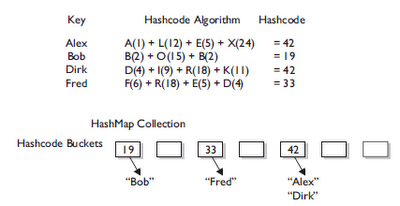Imagine a set of buckets lined up on the floor. Someone hands you a piece of paper with a name on it. You take the name and calculate an integer code from it by using A is 1, B is 2, and so on, and adding the numeric values of all the letters in the name together. A given name will always result in the same code; see Figure below.
Now imagine that someone comes up and shows you a name and says, “Please retrieve the piece of paper that matches this name.” So you look at the name they show you, and run the same hashcode-generating algorithm. The hashcode tells you in which bucket you should look to find the name.
Flaw:
Two different names might result in the same value. For example, the names Amy and May have the same letters, so the hashcode will be identical for both names. That’s acceptable. The hashcode tells you only which bucket to go into, but not how to locate the name once we’re in that bucket.
So for efficiency, your goal is to have the papers distributed as evenly as possible across all buckets. Ideally, you might have just one name per bucket so that when someone asked for a paper you could simply calculate the hashcode and just grab the one paper from the correct bucket (without having to go flipping through different papers in that bucket until you locate the exact one you’re looking for). The least efficient (but still functional) hashcode generator would return the same hashcode (say, 42) regardless of the name, so that all the papers landed in the same bucket while the others stood empty. The bucket-clerk would have to keep going to that one bucket and flipping painfully through each one of the names in the bucket until the right one was found. And if that’s how it works, they might as well not use the hashcodes at all but just go to the one big bucket and start from one end and look through each paper until they find the one they want.
This distributed-across-the-buckets example is similar to the way hashcodes are used in collections. When you put an object in a collection that uses hashcodes, the collection uses the hashcode of the object to decide in which bucket/slot the object should land. Then when you want to fetch that object (or, for a hashtable, retrieve the associated value for that object), you have to give the collection a reference to an object that the collection compares to the objects it holds in the collection.
Source : SCJP Exam Guide
